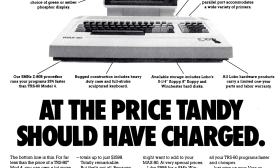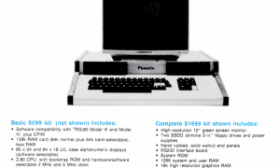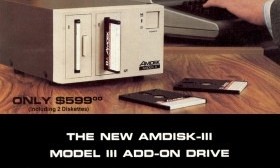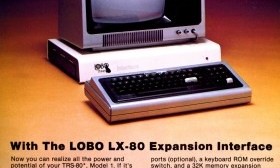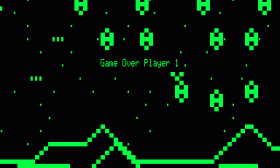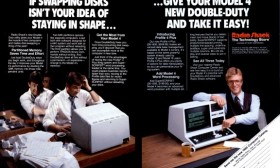The Lobo MAX-80 was a TRS-80 compatible computer sold by Lobo Systems (originally known as Lobo Drives International). Introduced at the 1982 National Computer Conference (where one could be reserved for a $100.00 deposit), the MAX-80 offered an impressive array of features including:
- a Z80B running at 5.07 MHz (making it one of the fastest microcomputers at the time)
- 64K of memory standard, with sockets for an additional 64K
- a double-density floppy disk controller with support for both 5 1/4" and 8" drives
- a hard disk controller interface
- video support through a standard RCA phono jack
- a screen size of 64 by 16 or 80 by 24 with a partially redefinable character set
- a TRS-80 style keyboard with CONTROL and ESCAPE keys, as well as F1 through F4
- one parallel port
- two serial ports
- real time clock with battery backup
(Read more...)
One of the more intriguing TRS-80 clones was the Phoenix, first advertised by Progressive Electronics in the August 1983 issue of 80 Micro. Designed by Keith Helwig, one of the proprietors of Progressive Electronics, the Phoenix was manufactured and sold in Lancaster, Ohio.
The Phoenix was offered in two configurations. The first was the “Basic kit” which cost $599.00 and included:
(Read more...)
In 1982, CompuServe changed their menu structure to “promote ease of use.” The new menus were grouped under six categories:
- Newspapers
- Home Services
- Business and Financial Services
- Personal Computing Services
- User Information
- Index
Any user could go directly to a page by using the “Go” command. For example, typing “Go HOM-1” would go to the “Home Services” menu page.
(Read more...)
CompuServe was the most famous of the early online services and the one with closest ties to the TRS-80. It actually started in 1969 as a timesharing system, renting mainframe computer time to businesses over phone lines. However, what most people remember as CompuServe dates to August 1979, launched as an online service for microcomputer users named MicroNET.
MicroNET opened the CompuServe network, normally reserved for businesses, to consumers with a telephone modem. Access was only available outside of business hours, when their mainframes were normally idle. MicroNET provided more or less raw access to the CompuServe mainframes running the TOPS-10 operating system. Users could use the included programs or create and run their own programs on the system.
(Read more...)
The Amdisk-III was an external dual-3″ (not 3 1/2″) floppy disk system introduced by Amdek Corporation in 1982. The TRS-80 Model III version was originally priced at $899, but that price was soon reduced to $599.00 and later $499.00. Versions were also available for the TRS-80 Color Computer, the IBM PC, and the Atari 400/800. 80 Micro tested a prototype version for the Model I, but it is unclear if that Model I version was ever sold. Amdisk also sold a single-drive system, the Amdisk-I, that was only available for the Apple II.
In 1982 to 1983, there were four “microfloppy” formats competing to replace the 5 1/4" floppy:
(Read more...)
The LX-80 was an alternative to the Radio Shack Expansion Interface that took a different approach to compatibility than the competition. It was originally announced by Lobo Drives International in Fall of 1979, but problems with the supplied operating system meant that it wasn’t released until closer to 1981. The original price was $799 (without memory), although that price had been reduced to $510.00 by late 1982. Lobo Drives also briefly advertised the LX-50, but it is unclear how that differed from the LX-80.
The LX-80 unit was extremely solid (constructed of 1/8″ thick steel) and was designed to have the Model I monitor rest on top. Although more expensive than other Expansion Interfaces, the LX-80 came with an impressive set of features:
(Read more...)
The LemonAid Loader was a device which greatly improved the ability of the TRS-80 to load programs using a CTR-80 or CTR-80A cassette recorder. It was designed by Wayne Lemons and sold through his company, Lemons Tech Services. The LemonAid Loader was available in two versions: the original which cost $12.99 (later $19.99) and a “deluxe” improved version which cost $18.99 (later $23.50). Both versions were compatible with the Model I and Model III, although cassette filtering was especially useful on the Model I.
The LemonAid Loader was described this way by a product announcement:
(Read more...)
The original version of Rear Guard was written by Neil Larimer for the Apple II. It was released by Adventure International, Scott Adams’ company, which also commissioned versions for other computers:
- John Anderson wrote the Atari 400/800 version
- Jim Hurd wrote the TRS-80 Color Computer version
- Wayne Westmoreland and Terry Gilman wrote the TRS-80 Model I/III version
One Adventure International advertisement described Rear Guard this way:
(Read more...)
DoubleDuty is a utility that uses the full 128K of a TRS-80 Model 4 to allow more than one program to be run at one time. Introduced by Radio Shack in 1984, DoubleDuty was written by Randy Cook, the author of Model I TRSDOS and VTOS.
DoubleDuty works by creating three sections, called partitions, out of the Model 4 memory. Partitions one and two each contain a complete Model 4 TRSDOS system. The third partition is reserved for running TRSDOS library commands.
(Read more...)
